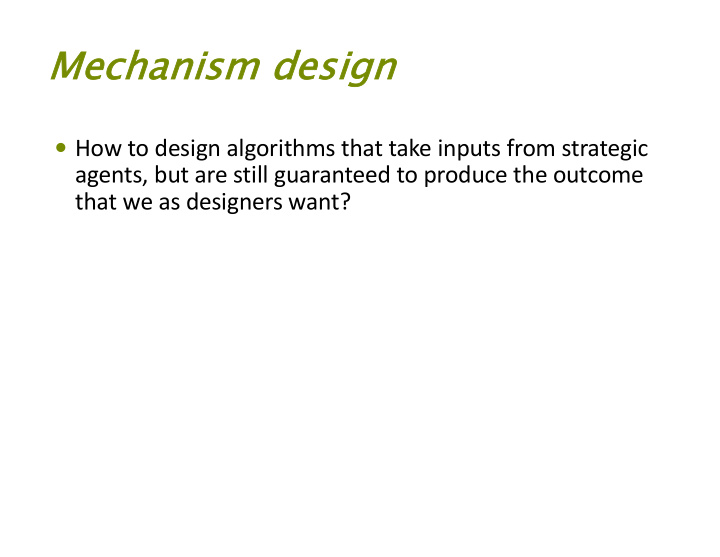



Me Mechanism m design How to design algorithms that take inputs from strategic agents, but are still guaranteed to produce the outcome that we as designers want?
Im Implementing a a fu function n players A: set of possible outcomes v i : A à R, where v i (a) is the value to player i of outcome a in A. private information of self-interested participant One of the common goals: implement a function f i.e., ensure that the outcome selected is f(v 1 , v 2 ,…, v n ) b v 1 v 2 . Outcome a mechanism . a= f (v 1 , v 2 ,…,v n ) . v n
Se Setup up To ensure correct outcome, must incentivize the players to “bid” truthfully => for this, need payments. Utility of agent i for outcome a: v i (a) – p i Challenge: choose payments so that mechanism is truthful – a player cannot gain by misreporting v i no matter what others do. v 1 Outcome a v 2 . mechanism a= f (v 1 , v 2 ,…,v n ) . . Payments (p 1 , p 2 ,…,p n ) v n p i = payment from player i.
A A fund undament ntal que uestion on For what functions f does there exist a payment rule that guarantees that it is in each players’ best interest to tell the truth, no matter what the other players do? When such a payment rule exists, we say f is “implementable”. One important case: when the goal is to maximize social welfare , i.e.
Vi Vick ckrey Clarke Grove ves (VC VCG) mech ch ae Outcome is: b 1 a*= argmax a S j b j (a) b 2 . mechanism . payment of i: . b n bj a Pitts r wsi Iinf.E'Ll EIF tindepg onteenefthat maximizes mechanism chooses bi b a t implementable
p i T.FI SW naximizations htt solve agents n
outcomes A sible 7Th Golf
Combi Co binatorial Auctions m items for sale n bidders competing for a subset of these items Each bidder i has a valuation v i (S) for each subset S of items XJamHisperagent Objective: Find a partition of the items (S 1 ,… S n ) that maximizes social welfare S i v i (S i ) Fifty i dam Samffensesselffguseg Applications: runs anchors Spectrum auctions. Fcc Abstraction of complex resource allocation problems such as routing, scheduling, load balancing, etc. VCG gives us a way to find the most efficient outcome. Tend
Ba Back ck to online adve vertising Since VCG is so general, convenient for complex scenarios such as those Facebook deals with. Outcomes are page layouts, which include a mix of organic and sponsored content. Dynamic resizing Bidders bid on events (click/like/app download) Practical issue (e.g. for Facebook) Design of user interface for bidding. Huge number of possible outcomes, impossible to elicit bid for each.
VC VCG for Face cebook Outcomes are page layouts, which include a mix of organic and sponsored content. Bidders bid on events (click/like/app download) Their bid specifies their value for each such event. v i (w) = value of event x Pr (event occurs in outcome w) Facebook devotes enormous effort to learning accurate estimates of these probabilities from data/history. Advertisers don’t need to know these probabilities.
Anot Anothe her practical issue ue Computational requirements Auction run every time user access news feed. Complexity of implementation.
Bi Bigger pict cture Online advertising ecosystem complex and enormous The process for how an ad gets shown to you when you go to a website involves real-time bidding/auctions and a number of intermediaries such as ad exchanges. See course web page. One interesting thing that has happened recently is that there seems to be a switch from second price auctions to first price auctions (in the display advertising market). As far as I can tell, the main reason is transparency.
Pr Problem with seco cond price ce “ In a second-price auction, raising the price floors after the bids come in allows [online auctioneers] to make extra cash off unsuspecting buyers…. The practice persists because neither the publisher nor the advertiser has complete access to all the data involved in the transaction, so unless they get together and compare their data, publishers and buyers won’t know for sure who their vendor is ripping off”
Ot Other significant issues Repeated auctions. Interaction between bidding and budgets.
Maximization Revenue in bidders litem 1 seller Vn Vi Va r v auction the optimal Find Objective has the highest all truthful anchors among revenue expected loss of generality without Truthfulness is nine I bidder vc.G Vntz SpaynatOeanu.p TpiIE g T t P p veil monopoly price L 2 bidders Vi Va U Q1 F feet 3wy g r witn reserve price of Run Vickrey anchor
a Vahey deck winner run payment p item at offer winter max r price p called regulars valuatnd F is A n density f easmgfn tff is x agmoy.de unit normal expound heavy tailed drown one valvahs bidders Thm_ If p'Iamen ei4m Tm aafmif.mid.IT is revenue reserve price with anchn Vickrey price monopoly peep argjax
Recommend
More recommend